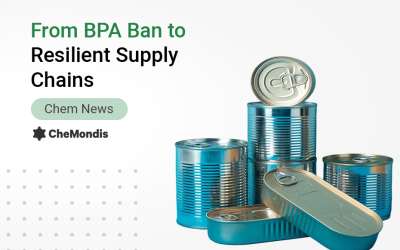The chemical industry is an ever-changing network of raw materials, processing, and logistics. As a Supplier or a Buyer, understanding the shifts in demand for specific substances is crucial to staying competitive and ensuring smooth operations. At CheMondis, we’ve recently analyzed a notable trend—a surge in the demand for certain key chemicals from Q1 to Q2. While these shifts might seem subtle at first, they reflect deeper trends in industrial activity and demand change.
This demand change shows important shifts in the market demand curve for several essential chemicals. In this blog article, we’ll dive into the substances that saw increased demand. Furthermore, we will explore the substances that might help to detect the underlying factors driving these shifts. By understanding these changes in demand, Suppliers and Buyers of the industry can better prepare for future fluctuations. Which allows them to focus on emerging opportunities.
Key Substances with Increased Demand Between Q1 and Q2
1. Urea
Urea, a nitrogen-based compound, experienced a significant increase in demand from Q1 to Q2. As one of the most widely used nitrogen fertilizers globally, the market demand curve for urea closely follows agricultural cycles, showing spikes during the planting season, which generally begins in Q2. The increased demand for urea in Q2 can be attributed to its critical role in improving crop yields. Farmers rely heavily on this compound to meet global food production needs. Changes in demand for urea could also be tied to sustainable farming practices .This shift reflects the broader demand change in agricultural chemicals.
2. Propylene Glycol
Propylene Glycol, widely used in antifreeze, pharmaceuticals, cosmetics, and food additives, saw a sharp change in demand between Q1 and Q2. This reflects broader shifts in the market demand curve, which may be influenced by both seasonal trends and industrial recovery after the global pandemic. The increased demand in Q2 can be linked to its use in cooling and antifreeze solutions, particularly as warmer months approach. The recovery of the personal care and food industries is driving demand for propylene glycol. Due to consumers turn to processed foods and cosmetics. This demand change highlights how industries are responding to both economic recovery and seasonal needs.
3. Glycerol
Glycerol (or glycerin) saw one of the sharpest increases in demand from Q1 to Q2. Widely used in cosmetics, pharmaceuticals, and food industries, glycerol’s change in demand is indicative of a larger market trend toward sustainability and health-conscious products. Glycerol’s rising demand curve in Q2 reflects its critical role in moisturizing creams, medicinal syrups, and as a biofuel product. Moreover, as consumers continue to prioritize self-care and health, the market demand curve for glycerol has shifted upward, reflecting sustained interest in products that use glycerol.
4. Potassium Hydroxide
Potassium Hydroxide, used in producing soaps, detergents, and alkaline batteries, also saw a steady demand change from Q1 to Q2. The hygiene and cleaning industries are driving this demand as consumer priorities have shifted towards cleanliness and sanitation during and after the global pandemic. Its use in batteries and energy storage solutions also highlights how the market demand curve is evolving as industries move toward greener technologies. The growing focus on sustainability is a major driver of this change in demand. It positions potassium hydroxide as an increasingly vital commodity in the modern industrial landscape.

What Does the Market Demand Curve Show?
The market demand curve for these substances shows how industrial activities, consumer behavior. Additionally seasonal factors interact to shape overall demand. In the case of urea and Propylene Glycol, the curve may reflect sharp increases during Q2 as sectors like agriculture and manufacturing hit their peak production cycles. Moreover, for glycerol and potassium hydroxide, the demand curve suggests sustained growth, driven by post-pandemic recovery and the global shift toward sustainability.
What Does Change in Demand Mean for Businesses?
For the businesses of chemical industry who are reliant on these substances, understanding the change in demand and shifts in the market demand curve presents both opportunities and challenges. The rising demand for chemicals can lead to increased revenue for Suppliers who are prepared to expand their customer and product portfolio base. However, higher demand may also lead to supply constraints or price increases.
Strategies for Navigating the Market:
1. Monitor Demand Changes:
Staying informed about shifts in the market demand curve will help businesses anticipate fluctuations and make proactive adjustments to their procurement strategies.
2. Diversify Supply Chains:
Diversifying Suppliers and establishing reliable partnerships are critical for mitigating the risks associated with supply chain disruptions. CheMondis helps you establish a relationship with trusted partners in the chemical industry.
3. Invest in Sustainable Solutions:
As sustainability becomes a driving force in the global market, investing in green technologies and sustainable practices is essential. Businesses that respond to the change in demand for eco-friendly chemicals will be well-positioned to thrive in the evolving landscape. You can add sustainability information to your products on CheMondis and let the Buyers know that you are contributing to a more sustainable future.
The surge in demand for urea, propylene glycol, glycerol, and potassium hydroxide from Q1 to Q2 reflects deeper market trends. Hence, understanding these demand changes and what the market demand curve shows, Suppliers and Buyers of CheMondis can better prepare for fluctuations and capitalize on opportunities. The increased focus on sustainability, post-pandemic recovery, and seasonal cycles are key drivers of this demand shift.
At CheMondis, we continue to monitor these trends closely to help businesses stay agile and informed. As industries evolve, understanding the change in demand for key chemicals will be crucial for maintaining a competitive edge in this dynamic market.




